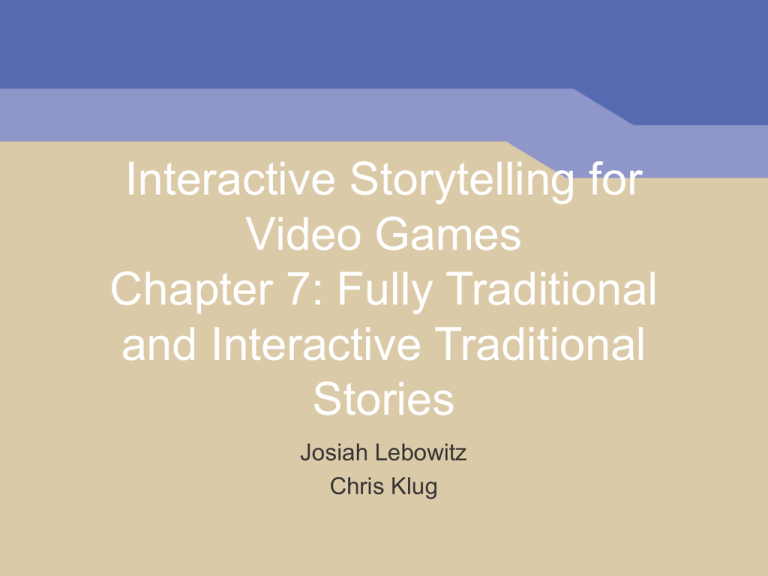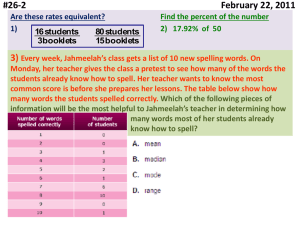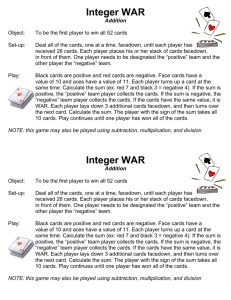Interactive Storytelling for Video Games Chapter 1: Game Stories
advertisement

Interactive Storytelling for Video Games Chapter 7: Fully Traditional and Interactive Traditional Stories Josiah Lebowitz Chris Klug Fully Traditional Stories and Video Games Fully traditional stories are the classic form of storytelling used in books and film. They can’t be changed in any way. Video games are, by definition, interactive. Fully traditional stories are not. There have been a few “games” which use fully traditional stories, but their lack of interactivity makes them closer to movies or digital novels than true games. Higurashi When They Cry Released by 07th Expansion in 2002 (PC). A Japanese visual novel with a dark suspense filled story. Essentially a first person novel with images, music, and sound effects. No interactivity other than advancing the text. The graphics and sound add a lot to the story but the lack of interactivity means it’s not a true game. What is an interactive traditional story? Interactive traditional stories combine the tightly controlled narrative of fully traditional stories with a degree of interactivity. They’re used in a wide variety of video games. While the player can’t change the main story in any significant way, he can still interact with the world and characters. FINAL FANTASY X Released by Square in 2001 (PS2). Features an deep and emotional interactive traditional story. The player can’t change the main plot in any way. Outside of story scenes, the player is free to explore the world and take on numerous optional quests. Creating Interactive Traditional Stories In many ways, the easiest type of game story to create. Because the main plot can’t be changed, it’s much like writing a movie script or novel. Depending on who you’re working for, you may be given a basic plot to expand or create everything yourself. You need to ensure that the story allows for a large amount of gameplay (fighting, exploration, puzzle solving, etc). Think about which scenes should and shouldn’t be interactive. Think about how the player will interact with the world and characters outside of key story scenes. Branching Dialogue and Interactive Traditional Stories In interactive traditional storytelling, branching dialogue can’t change the story so all the branches eventually come together. Despite that, the NPC should still react to the player’s choice and change the dialogue accordingly. NEVER loop a conversation until the player chooses the option you want. Have the NPC argue or reason with the hero to change his mind. NEVER give the player a choice between two essentially identical dialogue choices, it’s completely pointless. The Strengths of Interactive Traditional Stories The writer can fine tune every scene to ensure proper pacing and convey the right emotions to the player. Because the story can’t be changed, highly emotional scenes have far more impact than in player-driven stories. There’s no need to worry about the player screwing things up, losing track of the main plot, or missing vital pieces of information. It’s much easier to keep the story and characters believable and consistent than in player-driven stories. They provide the player with a strong illusion of control, while still presenting a well crafted narrative. FINAL FANTASY VII Released by Square in 1997 (PS). Heavily influenced the game industry. Features a deep twisting narrative full of memorable characters. Contains a death scene considered by many to be one of the most emotional moments in gaming history. The Weaknesses of Interactive Traditional Stories Because the player can’t change the main plot, the burden of creating an interesting, engaging, and ultimately satisfying story falls solely on the writer. If the writer isn’t up to the challenge, there’s nothing the player can do to improve the story. Poor pacing or uninteresting characters can ruin an otherwise good story. An unsatisfying ending can leave players feeling as if they wasted all the hours spent playing the game. Things to Consider Do you consider “games” using fully traditional stories, such as Higurashi, to be true games? Why or why List ten games you’ve played which use interactive traditional stories. Pick three of the games from your list. In what ways did they allow you to interact with their world and characters? When playing those three games, were there any times in which you really wanted to take control and change the story? Explain why and how you wanted to do so. Do you think the changes you proposed would have made the rest of the stories significantly better or worse? Why or why not? Do you think most other players would agree with you?











